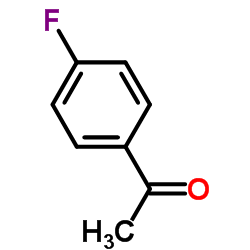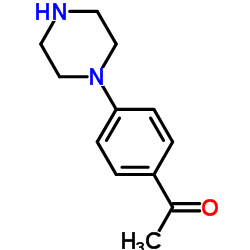26586-55-0
| Name | 1-[4-(4-methylpiperazin-1-yl)phenyl]ethanone |
|---|---|
| Synonyms |
1-[4-(4-methylpiperazino)phenyl]-1-ethanone
p-(4-Methylpiperazino)-acetophenone 1-[4-(4-methylpiperazin-1-yl)phenyl]ethan-1-one p-(4-methyl-1-piperazinyl)acetophenone 4-(4-methylpiperazino)-acetophenone 1-[4-(4-methyl-piperazin-1-yl)-phenyl]-ethanone EINECS 247-827-5 MFCD00023297 4-(4-Methylpiperazino)acetophenone ACETOPHENONE,4'-(4-METHYL-1-PIPERAZINYL) |
| Density | 1.068g/cm3 |
|---|---|
| Boiling Point | 365.1ºC at 760mmHg |
| Melting Point | 96-100 °C |
| Molecular Formula | C13H18N2O |
| Molecular Weight | 218.29500 |
| Flash Point | 159.1ºC |
| Exact Mass | 218.14200 |
| PSA | 23.55000 |
| LogP | 1.64390 |
| Vapour Pressure | 1.61E-05mmHg at 25°C |
Synonym:Non Section 2 - COMPOSITION, INFORMATION ON INGREDIENTS
Risk Phrases: None Listed. Section 3 - HAZARDS IDENTIFICATION EMERGENCY OVERVIEW
The toxicological properties of this material have not been fully investigated. Potential Health Effects Eye: No information regarding eye irritation and other potential effects was found. Skin: No information regarding skin irritation and other potential effects was found. Ingestion: The toxicological properties of this substance have not been fully investigated. Inhalation: The toxicological properties of this substance have not been fully investigated. Chronic: No information found. Section 4 - FIRST AID MEASURES Eyes: Flush eyes with plenty of water for at least 15 minutes, occasionally lifting the upper and lower eyelids. Get medical aid immediately. Skin: Get medical aid. Flush skin with plenty of water for at least 15 minutes while removing contaminated clothing and shoes. Wash clothing before reuse. Ingestion: If victim is conscious and alert, give 2-4 cupfuls of milk or water. Never give anything by mouth to an unconscious person. Get medical aid immediately. Inhalation: Get medical aid immediately. Remove from exposure and move to fresh air immediately. If not breathing, give artificial respiration. If breathing is difficult, give oxygen. Notes to Physician: Antidote: None reported. Section 5 - FIRE FIGHTING MEASURES General Information: As in any fire, wear a self-contained breathing apparatus in pressure-demand, MSHA/NIOSH (approved or equivalent), and full protective gear. Extinguishing Media: Use foam, dry chemical, or carbon dioxide. Section 6 - ACCIDENTAL RELEASE MEASURES General Information: Use proper personal protective equipment as indicated in Section 8. Spills/Leaks: Absorb spill with inert material (e.g. vermiculite, sand or earth), then place in suitable container. Avoid generating dusty conditions. Provide ventilation. Section 7 - HANDLING and STORAGE Handling: Wash thoroughly after handling. Use with adequate ventilation. Minimize dust generation and accumulation. Avoid contact with eyes, skin, and clothing. Keep container tightly closed. Avoid ingestion and inhalation. Use only in a chemical fume hood. Storage: Store in a tightly closed container. Store in a cool, dry, well-ventilated area away from incompatible substances. Section 8 - EXPOSURE CONTROLS, PERSONAL PROTECTION Engineering Controls: Facilities storing or utilizing this material should be equipped with an eyewash facility and a safety shower. Use adequate general or local explosion-proof ventilation to keep airborne levels to acceptable levels. Exposure Limits CAS# 26586-55-0: Personal Protective Equipment Eyes: Wear appropriate protective eyeglasses or chemical safety goggles as described by OSHA's eye and face protection regulations in 29 CFR 1910.133 or European Standard EN166. Skin: Wear appropriate protective gloves to prevent skin exposure. Clothing: Wear appropriate protective clothing to prevent skin exposure. Respirators: Follow the OSHA respirator regulations found in 29 CFR 1910.134 or European Standard EN 149. Use a NIOSH/MSHA or European Standard EN 149 approved respirator if exposure limits are exceeded or if irritation or other symptoms are experienced. Section 9 - PHYSICAL AND CHEMICAL PROPERTIES Physical State: Solid Color: Not available. Odor: Not available. pH: Not available. Vapor Pressure: Not available. Viscosity: Not available. Boiling Point: Not available. Freezing/Melting Point: 98 deg C Autoignition Temperature: Not available. Flash Point: Not available. Explosion Limits, lower: N/A Explosion Limits, upper: N/A Decomposition Temperature: Solubility in water: Specific Gravity/Density: Molecular Formula: C13H18N2O Molecular Weight: 218.30 Section 10 - STABILITY AND REACTIVITY Chemical Stability: Has not been fully evaluated. Conditions to Avoid: Dust generation. Incompatibilities with Other Materials: Strong oxidizing agents Hazardous Decomposition Products: Nitrogen oxides, carbon monoxide, carbon dioxide. Hazardous Polymerization: Has not been reported. Section 11 - TOXICOLOGICAL INFORMATION RTECS#: CAS# 26586-55-0: AM9472500 LD50/LC50: Not available. Carcinogenicity: 4-(4-Methylpiperazino)-acetophenone - Not listed by ACGIH, IARC, or NTP. Other: See actual entry in RTECS for complete information. Section 12 - ECOLOGICAL INFORMATION Other No information available. Section 13 - DISPOSAL CONSIDERATIONS Dispose of in a manner consistent with federal, state, and local regulations. Section 14 - TRANSPORT INFORMATION IATA Not regulated as a hazardous material. IMO Not regulated as a hazardous material. RID/ADR Not regulated as a hazardous material. Section 15 - REGULATORY INFORMATION European/International Regulations European Labeling in Accordance with EC Directives Hazard Symbols: Not available. Risk Phrases: Safety Phrases: S 24/25 Avoid contact with skin and eyes. WGK (Water Danger/Protection) CAS# 26586-55-0: No information available. Canada None of the chemicals in this product are listed on the DSL/NDSL list. CAS# 26586-55-0 is not listed on Canada's Ingredient Disclosure List. US FEDERAL TSCA CAS# 26586-55-0 is not listed on the TSCA inventory. It is for research and development use only. SECTION 16 - ADDITIONAL INFORMATION N/A |
CHEMICAL IDENTIFICATION
HEALTH HAZARD DATAACUTE TOXICITY DATA
|
| Safety Phrases | S24/25 |
|---|
|
~97% 
26586-55-0 |
| Literature: Zeitlmann, Lutz; Niestroj, Andre; Heiser, Ulrich Patent: US2011/224225 A1, 2011 ; Location in patent: Page/Page column 29; 30 ; US 20110224225 A1 |
|
~95% 
26586-55-0 |
| Literature: Romanelli; Manetti; Scapecchi; Borea; Dei; Bartolini; Ghelardini; Gualtieri; Guandalini; Varani Journal of Medicinal Chemistry, 2001 , vol. 44, # 23 p. 3946 - 3955 |
| Precursor 4 | |
|---|---|
| DownStream 0 | |



